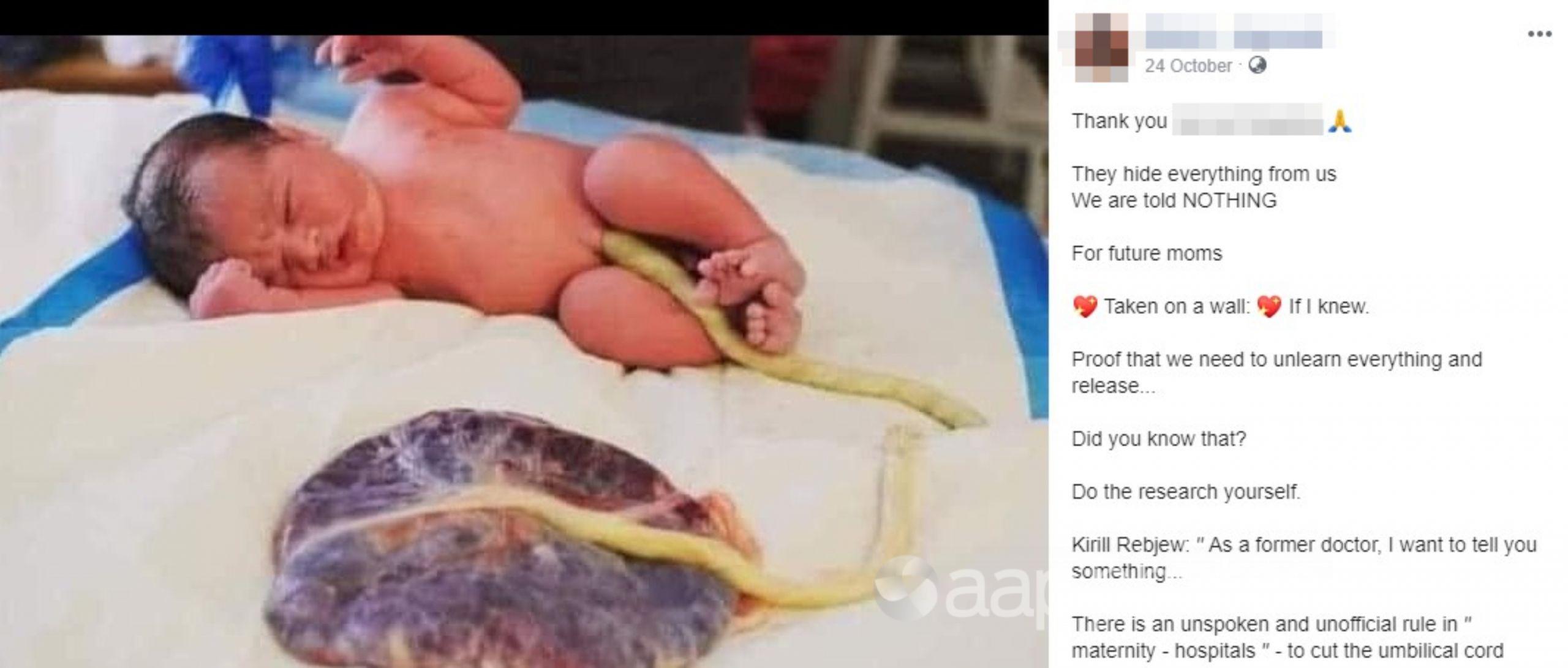The Statement
A Facebook post advises future parents to wait an hour before cutting their baby’s umbilical cord to avoid a range of negative health effects.
According to the October 24 post, there is an “unspoken and unofficial rule in maternity – hospitals” to sever the umbilical cord immediately after birth.
The post states that the “umbilical cord must NOT be cut until 1 HOUR AFTER BIRTH”.
“If the umbilical cord is cut immediately, the baby won’t have enough blood right after birth. However, the blood in the placenta contains the natural spectrum of baby immunity,” it reads.
“In other words, if the umbilical cord is cut immediately, part of the baby’s natural immunity is deliberately denied.”
The lengthy post goes on to claim that medical professionals benefited from babies having poor immunity as it provided a reason to vaccinate and medicate them.
At the time of writing, the post had been shared more than 450 times and had attracted more than 915,000 views.

The Analysis
While there is evidence that waiting a few minutes before clamping the umbilical cord has some health benefits, AAP FactCheck could not find any health institute or credible research that recommended waiting an hour.
The World Health Organization recommends waiting at least a minute before clamping the umbilical cord to reduce the incidence of iron-deficiency anaemia in infants.
“Delaying cord clamping (by more than one minute) allows blood flow between the placenta and neonate to continue, which may improve iron status in the infant for up to six months after birth,” the WHO article reads.
“This may be particularly relevant for infants living in low-resource settings with reduced access to iron-rich foods.”
But the WHO made no recommendations on waiting significantly longer periods than one minute to cut the umbilical cord.
The American College of Nurse-Midwives recommends waiting between two and five minutes before clamping the cord, depending on the circumstances (page 1).
It says immediately clamping the umbilical cord after birth had been practiced for decades and there were concerns that delayed clamping “would result in neonatal respiratory distress, polycythemia, and jaundice from circulatory overload”.
However, the ACNM says recent research found these complications did not occur and waiting a few minutes to clamp the cord increased the transfusion of iron-rich blood to the baby, increased birth weights and decreased the risk of iron-deficiency anaemia.
A report by the UK’s Royal College of Obstetricians and Gynecologists said research had found blood flow continued through the umbilical cord for a few minutes after birth (page 2).
It recommended deferring clamping the cord for at least two minutes, although it added that more research needed to be done into the alternative clamping strategies (page 2, 7).
The American College of Obstetricians and Gynecologists also advises delaying umbilical clamping for at least 30 to 60 seconds after birth, which it says has benefits although it also carries a small increase in the risk of jaundice.
The UK’s National Institute for Health and Care Excellence recommends waiting at least a minute. “If the woman requests that the cord is clamped and cut later than five minutes, support her in her choice,” it adds (page 67).
On the issue of early age immunisation, the Victorian government’s Better Health Channel says the measure is highly recommended for all children.
It says babies receive some passive immunity from their mothers, derived from antibodies transferred during pregnancy, but the level of antibody protection can be low and wears off quickly.
“This puts them at risk of diseases that can be prevented with vaccination,” it says.
The New Zealand Ministry of Health also says passive immunity did not last long after birth and “babies and children need immunisation to provide ongoing protection from many life-threatening diseases” (page 5).
Dr Alex Polyakov, an obstetrician and senior lecturer at the University of Melbourne Medical School, said there was no evidence that waiting an hour before clamping the umbilical cord had any health benefits.
“Once the umbilical cord stops pulsating, the blood flow has stopped and it is just dead tissue,” he told AAP FactCheck during a phone interview.
Dr Polyakov said all babies needed to be vaccinated, regardless of how long they remained attached to the umbilical cord.
“Vaccines are the only way to ensure the baby won’t get diseases like whooping cough or measles.”
University of Auckland associate professor of maternal and perinatal health Katie Groom said there was good evidence for waiting one minute before cutting the umbilical cord, particularly in preterm babies, but there was no evidence that waiting an hour was beneficial.
“There is ongoing research into the benefits of waiting longer than one minute, but that means three to five minutes and certainly not an hour,” Dr Groom told AAP FactCheck via phone.
She said there was no physiological reason why waiting an hour would improve immunity or reduce the need for vaccinations.

The Verdict
AAP FactCheck found no evidence that waiting an hour after birth to cut a baby’s umbilical cord has health benefits, or that cutting the umbilical cord earlier will result in health problems.
Experts also told AAP FactCheck that all babies were recommended to be vaccinated regardless of when the umbilical cord was cut.
False – Content that has no basis in fact.
AAP FactCheck is an accredited member of the International Fact-Checking Network. If you would like to support our independent, fact-based journalism, you can make a contribution to AAP here.
All information, text and images included on the AAP Websites is for personal use only and may not be re-written, copied, re-sold or re-distributed, framed, linked, shared onto social media or otherwise used whether for compensation of any kind or not, unless you have the prior written permission of AAP. For more information, please refer to our standard terms and conditions.

















